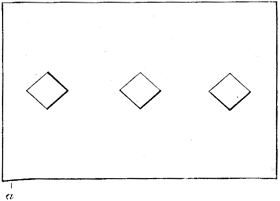
|
foreword to the online edition I. introductory II. common sharpers and their tricks III. marked cards and the manner of their employment IV. reflectors V. holdouts VI. manipulation VIII. the game of faro IX. prepared cards X. dice XI. high ball poker XII. roulette and allied games XIII. sporting houses XIV. sharps and flats
|
SHARPS AND FLATS
CHAPTER VIII THE GAME of FARO
The Needle-Tell Gaffed Faro BoxThe second kind of tell-box, which is used for the same purpose as that we have just investigated, we have already referred to as the 'needle-tell.' This box is also used with prepared cards, but the preparation is of a very different kind. In this instance there is no roughening of the surfaces of the cards, but those which are required to tell are cut to a slightly different shape to the others. In some respects the needle is an improvement upon the sand-tell; the cards are more easily shuffled than is the case with the 'sanded' ones, the clinging of which might arouse suspicion with an intelligent dealer. The dealing-box, however, is more complicated in its construction. The tell-cards are cut with a slight projection at one end. Fig. 43 will give an idea of the exact shape. The projecting end will be noticed at a. Needless to say, in the cards actually used the defect in the card would not be more pronounced than is absolutely necessary. In the chapter on prepared cards Maskelyne exposes an apparatus, called card trimmer, used to trim the edges of the cards for various purposes (not necessarily for cheating. That apparatus produces a straight cut, so it is not the tool used to prepare the cards for a needle-tell faro box. It's a pity that Maskelyne did not provide any descriptions of the apparatus used to prepare cards for a needle-tell. It's also a pity that there are no illustrations of the needle-tell box. The dealing box is so constructed that when either of the tell-cards arrives at a certain position (usually the fourth or eighth card from the top) the projecting corner presses against a light spring and causes a little 'needle' or point to project from the side of the box. Frequently one of the rivets with which the box is put together is made to push out a little. Whatever the index may be, however, it does not move sufficiently to attract attention. It is only those who are looking for it who know when it 'tells.' A movement of one thirty-second of an inch is ample for the sharp eyes of the swindlers to detect. The mechanism of the needle-tell, however, is not used solely in connection with cases where the players cheat the bank, it also forms a very necessary accessory to the 'two-card' box to be presently explained. Then it is used to let the dealer know when he is coming to the 'odd,' or fifty-third card. It should be noted that there used to be yet another type of a needle-tell box that was fitted with a different mechanism. The other type of needle-tell box would also require the cards to be prepared in a different manner. Instead of marking the card with a projecting ear, as in fig. 43, the cards would have small indentations at the sides. The apparatus used to prepare the cards in that manner was a special card punch. The base of the punch would have an alignment guide that enabled the user to make fine adjustments, for heavy or light work. The cards would be placed against the guide, one at a time, and the punch would clip off a miniature portion of the edge. As a result, some of the cards would be clipped at the sides; when these cards were placed inside the needle-tell box, the miniature needles (pegs, actually) would fall into the miniature crevices, whenever they pressed against the edge of a clipped card. On the outside of the box there would be a fake rivet that moved in an out. This kind of needle-tell box used more than one needle (or peg); there would be as much as four pegs, at slightly different positions that would read various valued of cards (or groups of cards). Of course, the playing cards would be prepared in such way that different values of cards (or groups) were clipped at different positions along the edges.
|
| « the game of faro (sand-tell box) | the game of faro (crooked faro banks) » |
home | introduction | book content | links | advertising | contact
